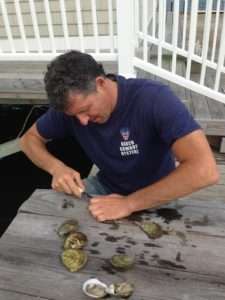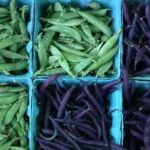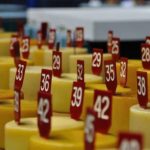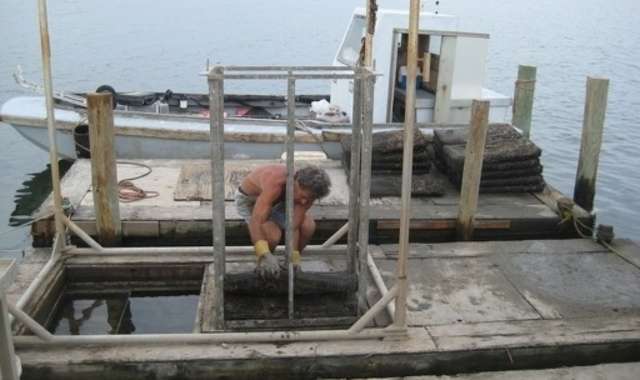By Sofia Perez
[Published by ZesterDaily.com, September 17, 2013]

Quartuccio, shucking some of his Blue Island oysters (Photo by Sofia Perez)
As we approach the floating dock, Chris Quartuccio cuts the boat’s engine, and the steady hum of the motor is replaced by what sounds like a large pile of broken plates being raked. We’ve reached Blue Island, Quartuccio’s oyster farm out on New York’s Great South Bay, the 29-mile-long body of water sandwiched between Fire Island and Long Island’s South Shore. On the other side of the dock, one of his employees is tumbling oysters, vigorously shaking mesh bags filled with the bivalves before stacking them in an open rack to be lowered back into the bay, where the oysters will continue to grow.
Tumbling heightens what wild oysters would naturally endure as they are tossed around by the tides, rasping off their still-feathery edges to produce the relatively smooth shells that are served up on ice at raw bars. Having spent the day listening to Quartuccio discuss the history of the region’s shellfish industry, however, it’s hard not to see tumbling as a metaphor for the trade and the lives of the people who ply it. Ebb and flow is putting it gently; it’s a saga filled with hope, desperation and Mother Nature’s merciless logic—from boom to bust to boom again, repeat ad infinitum.
Although he’s only 48, Quartuccio has lived through a few of these cycles already. A native of Sayville, New York, he started digging for clams when he was 12. “Back then, clam diggers here were making a lot of money. The better ones lived in the same neighborhoods as the doctors and lawyers. But as more people got into the business, they started putting a lot of pressure on the bay.” To maintain their high incomes, many began to work the winter grounds illegally, targeting areas of the bay that were rich in shellfish but that also served as important spawning zones. By the 1990s, the population of hard-shelled clams was wiped out.
Reviving the Real Blue Point Oyster
During my visit, Quartuccio takes me to Blue Point, the spit of land for which the renowned oyster is named. In 1908, New York state decreed that in order to be sold as a Blue Point, an oyster had to have spent at least three months in the Great South Bay—though the law is rarely enforced, and it’s not uncommon to see menus with oxymoronic offerings such as Chesapeake or Connecticut Blue Points.
Like clams, oysters here have had a checkered history, periods of great abundance followed by foreseeable—and unforeseeable—decline. “This area was paved with oysters back then,” said Quartuccio, referring to the first third of the 20th century, but things changed after the great hurricane of 1938, dubbed the “Long Island Express.” Killing more than 600 people, the storm destroyed large parts of Fire Island and created numerous inlets into the bay, causing the oyster beds to be silted over.
Later attempts to get the industry going again were foiled by brown tides, the result of excess nitrogen in the water, as well as the appearance of parasitic diseases that—although not a danger to consumers—decimated the oyster population. In 2002, a local fish hatchery manager was quoted in The New York Times as saying the Blue Point oyster had likely reached its end.
Or had it? Predictions of its demise appear to have been premature. Thanks to seeding efforts and laws prohibiting the harvest of the youngest oysters, parts of the bay have become hospitable again. Quartuccio purchased his farm back in 2005 (he owns the dock and leases his prime underwater location from the town of Islip), and his company now sells its delightfully briny, firm-textured Blue Points to a roster of high-end restaurants that includes New York’s Four Seasons, Craft, and Momofuku and San Francisco’s Waterbar.
Serving Them Up “Naked”
Despite his success, Quartuccio has learned to avoid putting all his shells in one bucket. In addition to his Blue Points, which he sells under the name “Blue Islands”—to distinguish them from competitors who’ve appropriated the original name for their oysters—he also deals in oysters from other parts of the country. And he’s always looking for the next big thing to promote.
To make a good living in the industry, he tells me, marketing is key. “If you don’t have the right name, I don’t care how good the oyster is. It’s not gonna sell.” With his newest item, a diver-harvested oyster from Long Island Sound, it appears he’s hit the jackpot. Christened after Times Square’s most famous tighty-whitey-clad denizen, the “Naked Cowboy” is Blue Island’s best-selling oyster to date. “When customers see the name on menus, they tell their waiters, ‘I want to know what the Naked Cowboy tastes like.’ That happens all the time.”
Although these calculations may seem crass to some, the economic realities of the industry defy the landlocked’s tendency to romanticize a seafaring life. These days, Quartuccio spends more time in the office than out on the water, but when I ask him whether he misses that part of the job, he smiles. “I’ve seen so many sunrises and sunsets. And when I say that, I mean they were long days. When you’re out here, day after day after day, in all kinds of weather—from 100 degrees to watching the ice form on the tips of your fingers… ” His voice trailed off, the echo of his Long Island accent hanging in the air for a moment. “I’ve seen enough for a lifetime.”



